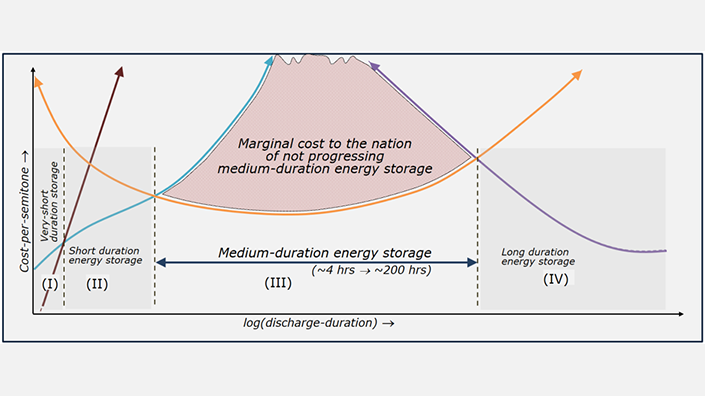No single set of technologies can deal with this huge range. In fact, there are four different ranges:
I, very-short duration storage (less than five minutes), handled best by flywheels, supercapacitors and possibly large inductors
II, short-duration storage (five minutes to four hours), dominated by electrochemical batteries and demand-side response actions
III, medium-duration storage (four to 200 hours), where thermo-mechanical solutions are the main options
IV, long-duration storage (over 200 hours), achieved mainly by storing bio-mass, bio-gas, ammonia, other synthesised fuels and/or hydrogen.

Present energy policy confines attention almost exclusively to categories II and IV, but category III will do the heavy lifting in a largely renewables-powered UK. The bulk (more than 90%) of all energy emerging from storage would be from such stores, and the greatest capital spend on future energy storage infrastructure in the future will be on such facilities.
Earlier this year I led a one-day meeting on medium-duration storage at the IMechE headquarters, focusing on its application in a net zero UK. Energy storage was defined very broadly to include storing energy prior to electricity generation and storage of ‘energy services’ such as heat, coolth and compressed air.
Two presentations addressed drivers for energy storage in Northern Europe, coming specifically from offshore wind. The offshore wind resource is more than sufficient to meet all energy needs, and exploiting even a part of this resource will raise major requirements for medium-duration storage. Henrik Stiesdal, a globally recognised expert in wind power and former CTO of Siemens-Gamesa Renewable Energy, demonstrated this point using Denmark as an example.
By far the largest energy storage capacity would need to be provided in the long duration stores. Seasonality of energy demand is not the main driver for long duration storage. Wind power, like demand, varies strongly with season and both are strongest in winter.
By contrast, solar power is seasonal and obviously peaks strongly in summer. If the monthly averages of wind and solar power were similar from year to year, there would be little need for long duration storage because a mix of roughly 80% wind and 20% solar would roughly match seasonality of demand. There is strong variation between years, however. Long duration energy storage facilities need only have relatively small power ratings. These cannot displace medium duration stores because the effective turnaround efficiency is relatively low and the cost of power-conversion equipment is relatively high.
Having a small amount of overcapacity in total renewable generation is very cost-effective overall, because of the corresponding reduction in energy storage requirements. Future systems that generate 10-15% more electricity than is expected to be consumed during the average year appear to be optimal, based on present cost assessments. If primary generation costs continue to reduce, then higher proportions of over-generation will be appropriate.
Beyond batteries
At the event, three presentations considered the storage of heat – especially in dedicated pits filled with water – the storage of coolth, and exploiting the liquefaction of air to enable large amounts of compressed air to be stored cheaply.
To many, energy storage means batteries. The energy storage market has naturally begun with short-duration storage and at present, this is the only market on which commercial returns are possible.
As the penetration of low-carbon generation increases, the discharge durations required also get longer. Private investment works well for battery-centred storage solutions, but will not work for the medium duration and long duration stores where the natural lifetimes of the facilities far exceeds private investment horizons and where good economics and good performance depends on realising individual installations at large scales.
Sir Chris Llewellyn Smith of Oxford University is leading a detailed review on behalf of the Royal Society into energy storage over long periods. He used data over a 37-year period to reveal huge variability between years in annual energy production. This remarkable observation justifies both a degree of net over-capacity in renewable energy for the average year, and points to a future requirement for enormous quantities of fuel storage – equivalent to several full weeks of present average electricity consumption.
A growing community
“It is clear that medium-duration energy storage will play a critical role in exploiting renewable power fully,” said Professor Paul Ekins of University College London, who chaired the event. “There are numerous promising options. They need to be demonstrated and deployed at scale to see which emerge as being viable in terms of performance and cost.”
Gareth Brett, chief technology officer of Highview Power, presented on liquid air energy storage. “Storage technologies with greater than four hours duration are a key enabler for the net zero energy system and I’m delighted to see a community coalescing around this view,” said Brett. “Scale and ‘locatability’ are important factors to ensure that the capabilities and benefits of storage can be accessed by the transmission network and value transferred to the owners of storage. These are features designed into Highview’s liquid air energy storage systems.”
The event was very well attended by industry, policymakers and academics. It ended with a panel session including substantial contributions from IMechE chief engineer Dr Jenifer Baxter, who emphasised the need to consider complete energy systems including heating and transport, and National Grid’s head of networks Julian Leslie, who pointed to the need for a shift from “dispatchable generation” towards “dispatchable demand”.
To access all the presentations and videos from the event, click here.
Want the best engineering stories delivered straight to your inbox? The Professional Engineering newsletter gives you vital updates on the most cutting-edge engineering and exciting new job opportunities. To sign up, click here.
Content published by Professional Engineering does not necessarily represent the views of the Institution of Mechanical Engineers.